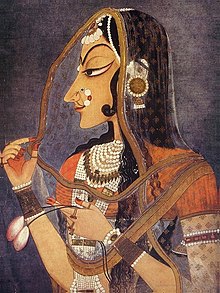

Nihâl Chand (1710–1782) was an Indian painter and poet who produced some of the best known examples of Rajput painting. He was the chief painter at the court of Kishangarh during the time of the ruler Savant Singh (also known as Nagari Das). He is attributed with a small group of paintings in a distinctive style, produced for Raja Savant Singh, and mostly depicting the king and Bani Thani as Krishna and Radha respectively. These are "widely held to be the finest of all Rajasthani miniatures", and are unusually large for their type, reaching 19 by 14 inches (48 x 36 cm).[1] He was a devout follower of Vallabha who had founded a Krishna-centric philosophy that surfaces repeatedly in his paintings as he signifies the deity with light blue skin.[2] He arrived in Kishangarh between 1719 and 1726.[3]
Gallery[edit]
-
Raja Savant Singh and Bani Thani as Krishna and Radha, ca. 1760
-
Radha and Krishna in the boat of love
-
Krishna and Radha, opaque watercolor and gold on cotton, ca. 1750
-
Krishna Celebrates Holi with Radha and the Gopis, 1750–60, Boston MFA
References[edit]
- ^ Harle, 395-396 (395 quoted); Kossak, 21, 113
- ^ "Radha and Krishna in the boat of love - Nihal Chand". Google Arts & Culture. Retrieved 24 March 2020.
- ^ Kossak, 21
Further reading[edit]
- Bani Thani
- Harle, J.C., The Art and Architecture of the Indian Subcontinent, 2nd edn. 1994, Yale University Press Pelican History of Art, ISBN 0300062176
- Kishangarh Miniatures - In Quest Of Divine Love
- Kossak, Steven (1997). Indian court painting, 16th-19th century. New York: The Metropolitan Museum of Art. ISBN 0870997831. (see index: p. 148-152; plate 56, 70)
External links[edit]




Well, that’s interesting to know that Psilotum nudum are known as whisk ferns. Psilotum nudum is the commoner species of the two. While the P. flaccidum is a rare species and is found in the tropical islands. Both the species are usually epiphytic in habit and grow upon tree ferns. These species may also be terrestrial and grow in humus or in the crevices of the rocks.
View the detailed Guide of Psilotum nudum: Detailed Study Of Psilotum Nudum (Whisk Fern), Classification, Anatomy, Reproduction